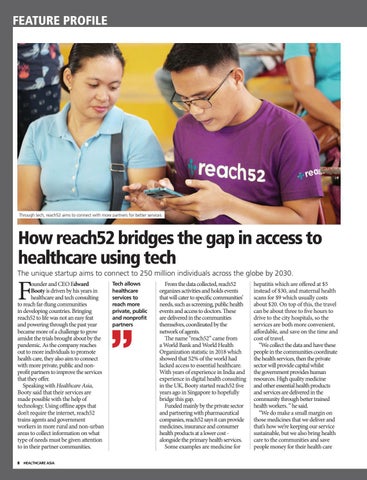FEATURE PROFILE
Through tech, reach52 aims to connect with more partners for better services
How reach52 bridges the gap in access to healthcare using tech The unique startup aims to connect to 250 million individuals across the globe by 2030.
F
ounder and CEO Edward Booty is driven by his years in healthcare and tech consulting to reach far-flung communities in developing countries. Bringing reach52 to life was not an easy feat and powering through the past year became more of a challenge to grow amidst the trials brought about by the pandemic. As the company reaches out to more individuals to promote health care, they also aim to connect with more private, public and nonprofit partners to improve the services that they offer. Speaking with Healthcare Asia, Booty said that their services are made possible with the help of technology. Using offline apps that don’t require the internet, reach52 trains agents and government workers in more rural and non-urban areas to collect information on what type of needs must be given attention to in their partner communities. 8
HEALTHCARE ASIA
Tech allows healthcare services to reach more private, public and nonprofit partners
From the data collected, reach52 organizes activities and holds events that will cater to specific communities’ needs, such as screening, public health events and access to doctors. These are delivered in the communities themselves, coordinated by the network of agents. The name “reach52” came from a World Bank and World Health Organization statistic in 2018 which showed that 52% of the world had lacked access to essential healthcare. With years of experience in India and experience in digital health consulting in the UK, Booty started reach52 five years ago in Singapore to hopefully bridge this gap. Funded mainly by the private sector and partnering with pharmaceutical companies, reach52 says it can provide medicines, insurance and consumer health products at a lower cost alongside the primary health services. Some examples are medicine for
hepatitis which are offered at $5 instead of $30, and maternal health scans for $9 which usually costs about $20. On top of this, the travel can be about three to five hours to drive to the city hospitals, so the services are both more convenient, affordable, and save on the time and cost of travel. “We collect the data and have these people in the communities coordinate the health services, then the private sector will provide capital whilst the government provides human resources. High quality medicine and other essential health products and services are delivered in the community through better trained health workers. ” he said. “We do make a small margin on those medicines that we deliver and that’s how we’re keeping our service sustainable, but we also bring health care to the communities and save people money for their health care










